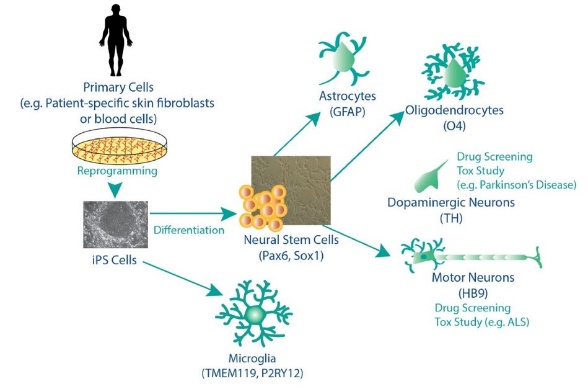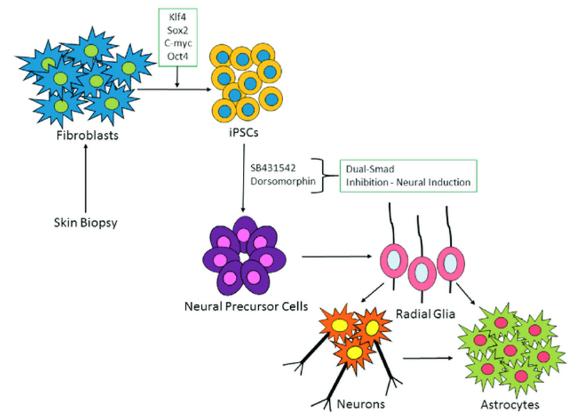Neural Differentiation from Induced Pluripotent Stem Cells
Effective and efficient generation of human neural stem cells and subsequently functional neural populations from pluripotent stem cells has facilitated advancements in the study of human development and disease modeling. Almost all types of neural cells, including but not limited to neural stem cells, neurons, astrocytes, oligodendrocytes, and microglia, can be derived from induced pluripotent stem cells (iPSCs) following developmental principles.
Neural Stem Cells

- Neural stem cells (NSCs) provide a life-long resource of neurons and glial cells in the brain and serve as the root for adult neurogenesis to develop, repair, and modulate nervous system functions. Using iPSC-derived NSCs, a wide range of neurological diseases have been studied, including monogenic and complex neural disorders.
- Through a carefully controlled series of signaling pathways and growth factors, iPSCs are guided toward a neuroectodermal fate. This commitment marks the beginning of neural differentiation, where the cells adopt NSC characteristics. These NSCs express characteristic markers, including N-Cadherin, SOX2, and NESTIN.
Neurons
- Neurons are the fundamental functional units of the nervous system, responsible for transmitting electrical signals and enabling communication between different regions of the brain. The specific types of neurons developed from iPSCs have been applied to neurological disease modeling and disease phenotype characterization.
- By modulating the expression of specific transcription factors and growth factors, iPSC-derived NSCs can be directed toward the neuronal lineage. For example, by controlling the activation of the Wnt signaling pathway and adding neurotrophic factors such as brain-derived neurotrophic factor (BDNF) and nerve growth factor (NGF), neurons with different phenotypes can be successfully generated.
Astrocytes

- With the growing knowledge of astrocyte biology, its role in neurological diseases is now increasingly appreciated. Similar to neurons, astrocytes are patterned by morphogen gradients along the rostro-dorsal axis and dorsal-ventral axis and exhibit heterogeneity in terms of subtypes and regionalities.
- However, the protocols of astrocyte differentiation from iPSCs remain limited. It is reported that using different combinations of RA, FGF8, and SHH to pattern astrocytes at the neural epithelial stage can generate spinal cord astrocytes in a shorter time.
Oligodendrocytes
Oligodendrocyte differentiation from iPSCs initially followed methods of ESC differentiation, including sequential induction of neural epithelial cells by RA and FGF, ventralization using SHH, and administration of PDGF to improve OPC expansion.
Microglia
In recent years, the derivation of microglia from iPSCs has become the focus of great interest. Some reports developed microglia-like cells from both human iPSCs and ESCs by inducing myeloid progenitors from EBs, mimicking yolk sac structures. These microglia-like cells express microglia-specific transcriptional factor PU.1 and surface markers IBA1, CD45 and CD11B.
Creative Bioarray Relevant Recommendations
The ability to differentiate iPSCs into specific neural cell types, such as NSCs, neurons, astrocytes, oligodendrocytes, and microglia, has opened up new avenues in neuroscience research and regenerative medicine. Creative Bioarray is an experienced and outstanding provider of neural and astrocyte differentiation services and differentiation kits.
| Services and Product Types | Description |
| Neural Stem Cells Differentiation | The process of iPSC differentiation to neurons and neuronal cells is of special importance for neurobiology and related disorders, considering the dearth of clinically relevant in vitro models available for research. |
| Astrocyte Differentiation | The generation of astrocytes derived from pluripotent stem cells opens up a new area for studying neurologic diseases in vitro, these models could be exploited to identify and validate potential drugs by detecting adverse effects in the early stages of drug development. |
| iPSC Differentiation Kits | We offer a wide range of products to support IPS Cell differentiation. These differentiated cells provide a highly desirable in vitro high-content toxicity and drug screening platform. |